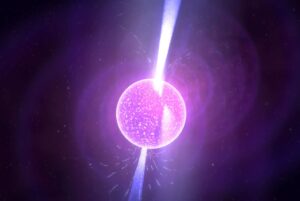The ‘mass gap’ might be ‘less empty than previously thought,’ researcher says

Illustration of a neutron star. Credit: Kevin Gill
An international research collaboration, including Northwestern University astrophysicists, has detected the first gravitational-wave signal from a merger between a potential neutron star and a mystery object in the “mass gap” — the range that lies between the heaviest known neutron star and the lightest known black hole.
The gravitational-wave signal alone cannot reveal the nature of the enigmatic object, which is 2.5 to 4.5 times the mass of our sun and located 650 million light-years from Earth. Future detections of similar events — especially those accompanied by bursts of electromagnetic radiation — could hold the key to solving this cosmic mystery.
“While previous evidence for mass-gap objects has been reported both in gravitational and electromagnetic waves, this system is especially exciting because it’s the first gravitational-wave detection of a mass-gap object paired with a neutron star,” said Northwestern’s Sylvia Biscoveanu, who managed the scientific paper and contributed to the analysis. “The observation of this system has important implications for both theories of binary evolution and electromagnetic counterparts to compact-object mergers.”
Access a copy of the study’s manuscript here.
Biscoveanu is a NASA Einstein Fellow at Northwestern’s Center for Interdisciplinary Exploration and Research in Astrophysics (CIERA), where she works with CIERA director and leading LIGO Scientific Collaboration astrophysicist Vicky Kalogera. Kalogera, the Daniel I. Linzer Distinguished University Professor of Physics and Astronomy at Northwestern’s Weinberg College of Arts and Sciences, was a member of the science case study team. Michael Zevin, a CIERA visiting scholar and astrophysicist at the Adler Planetarium, chaired the editorial team for the discovery paper and the science case study team.
Continue to the full Northwestern news article.

